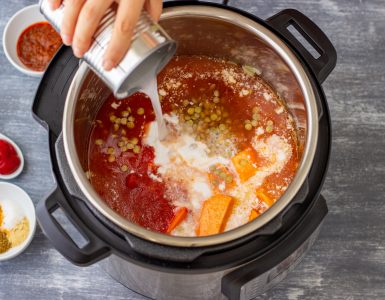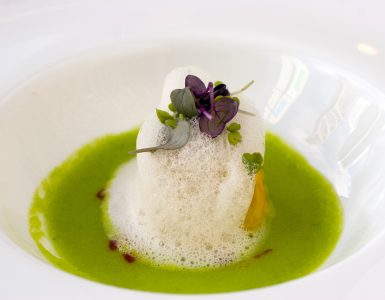This page may contain affiliate links. If you make a purchase through one of these links, we may earn a commission at no extra cost to you.
Long the domain of professional chefs in high-end restaurants, the sous vide technique has now become accessible for home chefs. With only a couple of pieces of equipment—most of which you probably already own—you can successfully start sous vide cooking at home.
Even on your first try, we think you’ll be blown away by how incredible the results are. And once you’ve had some practice, you’ll be making perfect meals every single time with almost no room for error. It’s easy to fall in love with this technique, which yields delicious results not only with steak (for which it’s so famous), but also with fish, vegetables, desserts, fruits, vegetables, eggs… the possibilities and combinations are endless.
Get started on your sous vide journey today by reading all about how to use this technique at home. We’ll cover what exactly sous vide is, what you need to get started, what kind of machine you should get, whether you actually need a sous vide machine at all, and how to step up your sous vide game with various accessories.
Table of Contents
What Is Sous Vide?
A relatively recent cooking method, sous vide (pronounced “SOO-VEED”) cooking involves putting food into watertight bags, then submerging those in a bath of water that’s held at a precise temperature until the food is done, which is often a matter of hours.
This technique lets you cook the food all the way through to the perfect doneness every single time, without running the risk of undercooking or burning it. If you like a medium-rare steak, you’ll never again need to worry about accidentally leaving it on the grill for a minute too long.
Because sous vide cooking involves bringing the food to precisely the final temperature you want, you have a lot of flexibility in cooking time. The food won’t overcook in the way we’re used to; it will never burn, char, or turn from medium-rare into well-done.
With that said, it is possible to cook food too long in a sous vide bath. Instead of burning, though, the food will simply lose quality in terms of texture. Fortunately, the time between “perfectly cooked” and “overcooked” is measured in hours instead of minutes for most sous vide recipes. This makes it a perfect option for those busy days at home; just throw something in several hours before dinner time, then finish and serve it whenever you’re ready.
The Essentials: What You Need to Start Sous Vide Cooking at Home
Far from requiring a long list of complicated pieces of equipment, sous vide takes only three basic items:
- A vessel large enough to hold your food in a water bath with plenty of room to spare
- Plastic bags to contain the food you’ll cook
- A sous vide machine (or another device capable of sous vide cooking—more on this in a bit!)
Do you have a large pot, like one you might use for canning? What about Ziploc bags? If so, congratulations—you already have two out of the three necessary items!
Note: Ziploc-brand bags specifically are BPA-free and dioxin-free. If you’re concerned about these chemicals, either use official Ziploc bags or make sure that your preferred brand also avoids them.
If you have your pot and bags ready, all you’ll need is a way to keep the water bath at the correct temperature. This is where a sous vide machine comes into play. If you don’t already have one, read the next section to learn about the two distinct types and our recommendations.
Which Sous Vide Machine Should I Get?
It’s a testament to the ever-increasing popularity of sous vide cooking that you now have an abundance of options to choose from. We’ve narrowed down the options for you into a few top suggestions. But before we get into our recommendations, we need to clarify that there are two main types of sous vide machines.
First, there are immersion circulators, which are thick sticks (similar in shape and style to an immersion blender) that you put into a separate container of water. Typically this container doesn’t come with the immersion circulator, and you need to supply it yourself.
Second, there are standalone sous vide machines, which are more akin to a slow cooker or bread machine in size and design. They take up more counter space, but they’re definitely more convenient in that you don’t need to source a separate container yourself. Plus many of them aren’t only for sous vide, so you can have one device that also potentially lets you cook rice, sear, saute, make yogurt, slow cook, and more.
Both types of sous vide machines work well. In terms of function, we don’t suggest either one over the other. Instead, it’s all a matter of personal preference. If counter space is at a premium and you want something you can easily tuck away, you might prefer an immersion circulator. But if you tend to slow cook or make rice frequently and also want sous vide capability, a multi-cooker with a sous vide setting may be the perfect fit.
If you want an immersion circulator, we recommend the Anova Culinary Sous Vide Precision Cooker for its extremely reasonable price, overall great quality, and incredible capacity. While it has WiFi capability and an associated app, you can also set it manually if you prefer.
For a full sous vide machine, our favorite is the Wolf Gourmet Programmable 6-in-1 Multi Cooker. You can expect the wonderfully high quality and durability that this high-end brand is famous for, along with a reliable sous vide function and several other cooking options.
For more recommendations and other options, check out our lists of the best sous vide machines (for standalone sous vide machines, including several with multiple functions) and the best immersion circulators.
Can You Cook Sous Vide Without a Machine?
Remember I said we’d talk more about other devices capable of sous vide cooking? It’s time to get into that topic!
First: yes, you technically can sous vide on your stovetop. And no, we do not recommend it. Trying to get the water to stay at the exact right temperature for the entire hours-long process of a sous vide cooking session is a challenge to say the least, and a potential disaster at worst. Too hot, and your food will overcook, defeating the whole purpose. Too low for too long and you risk having your food in the temperature “danger zone,” which is hazardous and can lead to serious illness or even death.
Even if you have an accurate thermometer to measure the water temperature, you’ll need to check it frequently to make sure you don’t need to adjust the heat. And if you’re going to be obsessively checking on your food and potentially cooking it to the wrong temperature… well, you might as well just cook it the normal old-fashioned way.
With all that said, you don’t need a dedicated sous vide machine to use this technique. You may already have a machine that’s capable of sous vide. Do you have a multi-cooker, a slow cooker, or an Instant Pot? If so, you may already have everything you need. Certain models have designated sous vide settings, and others have options you can use to achieve a sous vide technique. If you’re not sure how to use yours or whether it will work for this purpose, consult the manufacturer’s instructions or look up information specific to your device.
If you don’t yet have one of these devices that works for this purpose, keep in mind that you can invest in one of them instead of an option that’s just for sous vide. Several of our favorite sous vide cookers are actually multi-purpose machines with anywhere from five to eleven functions.
Accessories to Help You Step Up Your Game
Now that you’re becoming a sous vide expert, are you ready to kick things up a notch and complete your home sous vide setup? While these items aren’t absolute necessities, they can definitely be helpful to have.
We recommend:
- Bags specifically designed for sous vide. While Ziploc bags work fine, sous vide bags are designed to withstand elevated temperatures for a longer period without softening or opening.
- A vacuum sealer. You can use the water displacement method to remove almost all of the air from your bags, but a proper vacuum sealer will help you eliminate even more and potentially work better for prolonged cook times and storage.
- A sous vide rack. Once you get into cooking multiple things at once in your sous vide bath, a rack will be incredibly useful. It keeps the bags separate from each other while holding them underwater, allowing for the circulation that promotes an even temperature throughout the bath.
- Sous vide weights. No matter how much air you remove from the bag, some foods just insist on trying to float. This is not only bad for cooking evenness, but can even be dangerous if the portion of the food that isn’t submerged in water ends up at the wrong temperature for too long. Weights eliminate this problem by ensuring that the bags stay fully submerged.
- A kitchen torch. Most proteins need a good sear once they’re been through the sous vide process. They’re fully cooked through, of course, but they lack the luscious brown crust on the outside. But searing them in a pan or on the grill can lead them to cook further, which defeats the purpose. In our tests, we’ve found that a kitchen torch works well to create a nice sear without significantly further cooking the food.
- A smoking gun. Another of the side effects of letting your food gently bask in a cozy bath until it’s cooked to perfection is that it never experiences the harsh world of blazing heat, flames, and smoke. Give it some of that rugged flavor by using a smoking gun or smoke infuser.










